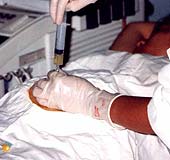Currently, with prenatal diagnostic methods using screening tests, healthcare providers can detect fetal abnormalities from within the mother’s womb and take timely action.
 |
|
Amniocentesis for diagnosing fetal abnormalities through chromosomal analysis (Photo: NLĐ) |
Every year, Tu Du Hospital in Ho Chi Minh City sees approximately 300 children born with congenital defects referred to its Neonatology Department. At Hung Vuong Hospital in Ho Chi Minh City, in 2004, there were 82 cases of congenital defects at birth, accounting for 0.31% of all births at the hospital that year; this number increased to 148 cases in 2005, representing 0.53%.
Fetus with an extra chromosome 21
In early July 2006, Ms. N.T.M.N, a 31-year-old resident of Tan Binh District, Ho Chi Minh City, who was 20 weeks pregnant, visited Tu Du Hospital to undergo testing for Down syndrome in her fetus. Since the beginning of her pregnancy, she had regularly attended check-ups at Tu Du Hospital. Initial tests indicated that the fetus was normal. However, by the 20th week, some tests revealed abnormal signs in the fetus. At her request, the Genetic Department doctors performed amniocentesis and conducted chromosomal analysis on the fetus. The results indicated that the fetus had an extra chromosome 21, a marker for Down syndrome. After several tests, the doctors advised Ms. N. to consider terminating the pregnancy.
Older mothers, higher risk of defects
Vietnam has one of the highest rates of congenital defects in the world. This is according to Professor and Doctor Tran Dong A, Deputy Director of Children’s Hospital No. 2 in Ho Chi Minh City. The exact causes are not clearly defined; however, factors such as genetics, chromosomal abnormalities, maternal exposure to chemicals or radiation during pregnancy, and improper medication use are suspected. Particularly, older mothers are at a higher risk of giving birth to children with defects. For a mother aged 20, the likelihood of having a baby with Down syndrome is 0.06%; this risk increases to 0.08% at age 25 and exceeds 0.1% by age 30. Statistics from Tu Du Hospital indicate that hydrocephalus is the most common defect, followed by congenital heart disease, chromosomal disorders, Down syndrome, anencephaly, clubfoot, cleft lip and palate, and umbilical hernia.
The timing of detection varies based on the severity of the fetal abnormalities. Major defects, such as anencephaly or multiple congenital anomalies, can often be detected by ultrasound as early as the 9th week of pregnancy. Dr. Vu Thi Nhung, Director of Hung Vuong Hospital, states that for these cases, doctors typically advise mothers to terminate the pregnancy since the baby cannot survive after birth.
For less severe defects, which are harder to detect, diagnosis may not occur until tests at the fifth month of pregnancy. For treatable minor defects such as cardiac issues, abdominal wall defects, spina bifida, and cleft lip and palate, obstetricians will monitor the cases, consult with specialists, or refer to pediatric hospitals for surgery immediately after birth. Additionally, mothers are prepared to minimize trauma during delivery.
Regular prenatal screening is recommended
According to Dr. Huynh Thi Thu Thuy, Deputy Director of Tu Du Hospital, from the 14th week of pregnancy onwards, mothers should undergo regular screening tests. In the first 13 weeks, mothers will undergo diagnostic tests to confirm whether the fetus has developed and to assess heart activity via ultrasound. Starting from the 13th week, blood tests will be used to diagnose certain fetal defects. If results raise concerns, doctors will proceed with chromosomal analysis through amniocentesis and cell culture from amniotic fluid.
Dr. Phung Nhu Toan from the Genetic Department of Tu Du Hospital warns that terminating pregnancies with significant defects or undergoing abortions, if not done carefully, can cause complications for mothers and may lead to infertility due to blocked fallopian tubes. If significant fetal defects are not detected early enough for pregnancy termination, serious obstetric complications may arise during delivery, potentially resulting in uterine rupture and maternal death.


















































